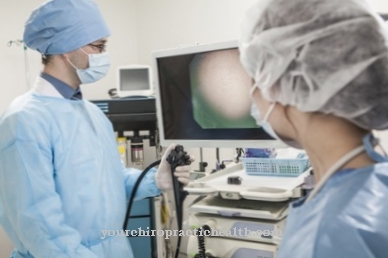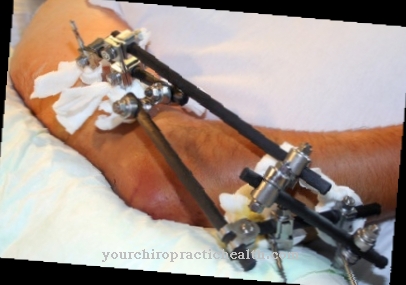In the Electroencephalography (EEG) is a non-invasive method for measuring electrical brain activity. In German one also speaks of brain wave measurement. Electroencephalography is completely harmless and is routinely used both in medical diagnostics and for research purposes.
What is electroencephalography?

The term Electroencephalography is a composition of the Greek expressions encephalon (brain) and graphein (to write). It describes the measurement of potential fluctuations in the cerebral cortex using electrodes attached to the scalp.
All neurons in the brain have what is known as a resting membrane potential, which changes when excited. The change in state of an individual nerve cell cannot be detected from the outside; but if larger groups of neurons are excited synchronously, the changes in potential add up and can also be measured outside the skull.
Since the signal is attenuated by the cranial bones, meninges, etc. and is only in the μV range, it must be additionally amplified. In addition, background noises must be filtered out.
The measured fluctuations in potential are shown graphically over time in an electroencephalogram.
From these EEG curves, trained experts can read out disease processes, but also healthy, research-relevant brain activities. Electroencephalography was developed in the 1920s by the Jena neurologist and psychiatrist Hans Berger (1873-1941).
Function, effect & goals
In healthy people that finds ElectroencephalographyCharacteristic rhythmic activity patterns, depending on the state of wakefulness and cognitive performance: Alpha waves (8-12 Hz) occur when the eyes are awake and relaxed, and beta waves (13-30 Hz) when the eyes are open. With mental exertion, gamma waves appear in the frequency range above 30 Hz.
In contrast, theta waves (4-8 Hz) and delta waves (<4 Hz) are typical during sleep. Fundamental deviations from these oscillations indicate neurological disease processes. Electroencephalography is particularly important for diagnosing and monitoring the course of epilepsies, in which seizure-like discharges occur in large groups of nerve cells. Here the EEG helps to determine the type and duration of the seizures and (in focal epilepsy) to determine the focus of the seizure.
Electroencephalography is also used for other disorders of consciousness: in sleep medicine, an all-night EEG is often derived. From the recorded hypnogram can u. a. read off the latency to sleep, the duration and distribution of sleep stages and wake-up reactions. In most cases, electroencephalography is combined with other physiological measurement methods such as polysomnography, e.g. B. with electrocardiography (EKG) or pulse oximetry (non-invasive determination of the arterial oxygen content).
In this way, different sleep disorders such as insomnias, parasomnias or dyssomnias can be recognized and objectified. In addition, electroencephalography helps to determine the depth of anesthesia, but also the depth of a coma. Electroencephalography is a tool used to determine brain death.Since the cerebral cortex is constantly showing electrical activity even when it is at rest, the absence of this is an indication of irreversibly dead tissue.
In addition to its clinical areas of application, electroencephalography is also frequently used in research. Here, the relevant changes in the EEG curve are usually more subtle and cannot be read directly, but have to be filtered out with the help of statistical software. Electroencephalography is often used to measure reactions and reaction times to certain stimuli in experiments. Electroencephalography is particularly suitable for this, as it has a high temporal resolution (in the millimeter range).
In this respect, it is clearly superior to other examination methods such as magnetic resonance tomography (MRT), computed tomography (CT) and positron emission tomography (PET). The spatial resolution of electroencephalography, however, is relatively coarse. In addition, only the electrical activity of the cerebral cortex is recorded; Deeper brain areas can only be examined indirectly using electroencephalography (via their influence on the cerebral cortex).
Electroencephalography has been used commercially and therapeutically for a number of years in so-called brain-computer interfaces (BCI). This technology allows computers to be controlled directly with the help of brain waves and is used for play purposes, but also enables the severely paralyzed to communicate with the outside world.
You can find your medication here
➔ Medication for sleep disordersSide effects & dangers
The Electroencephalography is a completely safe and harmless examination method. Only electrodes are stuck to the outer scalp and electrical signals that are already present are derived. The patient or test person is not exposed to any radiation or other danger. A routine examination takes about 20-30 minutes; Long-term electroencephalography may be necessary for special questions.













.jpg)

.jpg)
.jpg)











.jpg)